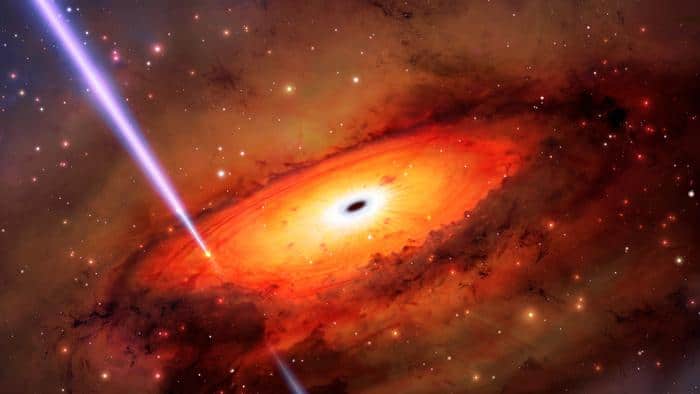
Most stars meet their inevitable demise in ways that can be predicted based on their mass. Take our own Sun, for example. It’s a relatively low-mass star that, as it ages and runs out of fuel, will gracefully shed its outer layers and fade into a white dwarf.
On the other hand, more massive stars burn brighter and burn out faster, culminating in cataclysmic supernova explosions that give birth to extraordinary objects such as neutron stars and black holes. Then, if two stellar remnants form a binary system, they also can eventually collide.
But recent research has uncovered a remarkable, previously unseen fourth option, a long-hypothesized but elusive phenomenon.
Stellar ping-pong
While searching for the origins of a long-duration gamma-ray burst (GRB), astronomers using the Gemini South telescope in Chile and other telescopes, found a collision of stars or their remnants in the chaotic and densely packed vicinity surrounding a supermassive black hole within an ancient galaxy.
“These new results show that stars can meet their demise in some of the densest regions of the Universe where they can be driven to collide,” said Andrew Levan, Radboud University astronomer and lead author of the study appearing in the journal Nature Astronomy.
“This is exciting for understanding how stars die and for answering other questions, such as what unexpected sources might create gravitational waves that we could detect on Earth.”

Ancient galaxies, having long surpassed their prime in terms of star formation, possess only a handful of giant stars, the primary progenitors of long GRBs. A long GRB is any GRB lasting more than two seconds.
However, their cores remain a bustling hub of activity, teeming with stars and an assortment of ultra-dense remnants such as white dwarfs, neutron stars, and black holes.
Astronomers have long postulated that in the tumultuous maelstrom enveloping a supermassive black hole, it was only a matter of time before two stellar objects collided, giving birth to a GRB. However, evidence of such mergers has remained frustratingly elusive.
The first hints that such an extraordinary event emerged on Oct, 19, 2019, when NASA’s Neil Gehrels Swift Observatory detected a brilliant burst of gamma rays that persisted for just over a minute. While these bursts typically originate from supernovae resulting from dying stars with at least 10 times the mass of our Sun, exceptions do exist.
Intrigued by the event, the team extensively observed the fading afterglow of the GRB using the Gemini South telescope. This allowed them to locate the GRB, now coined GRB 191019A, within 100 light-years of the ancient galaxy’s core, near the supermassive black hole.
Surprisingly, no evidence of a supernova was found, leading them to deduce that the burst likely resulted from the merger of two compact objects.
Scientists believe it is plausible such events are routine in similarly crowded regions across the Universe but have remained unnoticed until now. One possible reason for their obscurity is the abundance of dust and gas in galactic centers, which could obscure both the initial burst of the GRB and its subsequent afterglow. This GRB represents a rare exception, allowing astronomers to detect and study the burst’s effects.
The researchers aim to discover more of these extraordinary events. Their hope is to match a GRB detection with a corresponding detection of gravitational waves, which would provide further insights into their true nature and confirm their origins, even in the most opaque environments. The Vera C. Rubin Observatory, scheduled to come online in 2025, will be instrumental in advancing this line of research.









